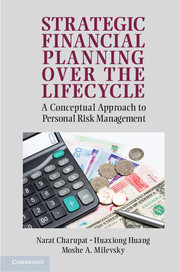Book contents
- Frontmatter
- Contents
- Acknowledgments
- 1 Introduction and Motivation
- 2 Mathematical Preliminaries – Working with Interest Rates
- 3 Personal Balance Sheet and Human Capital
- 4 Consumption Smoothing and Optimal Savings
- 5 Debts, Loans, and Mortgages [Canadian Content]
- 6 Personal Income Taxes [Canadian Content]
- 7 Risk, Utility, and Insurance
- 8 Mortality Risk and Life Insurance
- 9 Investment and Diversification
- 10 The Mathematics of Portfolio Diversification
- 11 Housing Decisions
- 12 Pensions and Retirement [Canadian Content]
- 13 Advanced Material: Part I. Continuous Time and the Calculus of Variations
- 14 Advanced Material: Part II. Stochastic Optimal Control and the HJB Equation
- 15 Concluding Thoughts and Next Steps
- Bibliography
- Index
14 - Advanced Material: Part II. Stochastic Optimal Control and the HJB Equation
Published online by Cambridge University Press: 05 June 2012
- Frontmatter
- Contents
- Acknowledgments
- 1 Introduction and Motivation
- 2 Mathematical Preliminaries – Working with Interest Rates
- 3 Personal Balance Sheet and Human Capital
- 4 Consumption Smoothing and Optimal Savings
- 5 Debts, Loans, and Mortgages [Canadian Content]
- 6 Personal Income Taxes [Canadian Content]
- 7 Risk, Utility, and Insurance
- 8 Mortality Risk and Life Insurance
- 9 Investment and Diversification
- 10 The Mathematics of Portfolio Diversification
- 11 Housing Decisions
- 12 Pensions and Retirement [Canadian Content]
- 13 Advanced Material: Part I. Continuous Time and the Calculus of Variations
- 14 Advanced Material: Part II. Stochastic Optimal Control and the HJB Equation
- 15 Concluding Thoughts and Next Steps
- Bibliography
- Index
Summary
Learning Objectives
Until now, we have assumed that there is no uncertainty other than the length of your lifetime. In real life, however, this is not the case. In this chapter we extend the results in the previous chapter by including uncertainties in both investment return and wage income. We start by presenting the standard materials on dynamic optimal asset allocation and consumption under the continuous time framework, originally developed by Robert Merton in a series of papers (1969, 1971) that led to him being awarded the Nobel Prize Memorial in Economics. We then conclude the chapter with a brief presentation of an advanced stochastic lifecycle model.
Dynamic Asset Allocation and Optimal Consumption
Let us for the time being forget about the lifecycle model(issues related to mortality risk and retirement) and instead consider a classical problem in finance. Suppose that you have inherited or accumulated a certain amount of money Mt at time t. You have a choice between keeping your money in a safe bank account (cash) or investing it in the stock market, which promises a greater return on average. Of course the stock market is volatile and you may lose some or all of your investment (if you are one of the many who bought tech stocks before the great tech bubble burst, for example). So if you are risk averse and belong to those people who will lose sleep worrying about the possibility of losing your investment, clearly you face a dilemma: money in the savings account is safe but the return is low while the stock market might give you a greater return but you face the possibility oflosing your investment.
- Type
- Chapter
- Information
- Strategic Financial Planning over the LifecycleA Conceptual Approach to Personal Risk Management, pp. 315 - 344Publisher: Cambridge University PressPrint publication year: 2012



